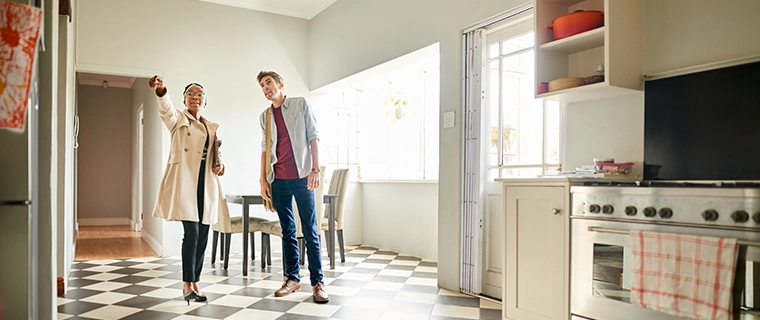There are dozens of factors to consider when buying a house, from your lifestyle and desired neighborhood to your home’s style and features. It also involves finding the right home that fits your budget—including your loan term, interest rate, and monthly payments. If you’re debating your mortgage options, consider if an adjustable-rate mortgage (ARM) works for you.
What is an adjustable-rate mortgage?
An adjustable-rate mortgage, sometimes called a variable-rate mortgage, is a home loan with an interest rate that fluctuates throughout the loan term based on the market. ARMs typically start with a lower interest rate compared to fixed-rate mortgages, making them perfect for borrowers looking for the lowest possible rate.
How does an ARM work?
Adjustable-rate mortgages have fluctuating interest rates. Depending on your lender and the ARM you choose, the rate will stay the same for a set period. The rate could stay the same for the first five months or five years—your monthly payment then fluctuates after the lock period. The lock period is the set time where borrowers lock in the typically low interest rate. Once that period ends, the rate resets to the prevailing interest rate.
ARMs are typically advertised as two numbers. The first number represents the lock period, or the length of time your initial interest period lasts. The second number represents how often your rate changes once the lock period ends. For example, a 5/1 ARM has a fixed interest rate for the first five years. Once the five years conclude, the rate can adjust once annually until the loan term ends.
Most ARMs feature an adjustment cap, which limits how much the interest rate can fluctuate at each adjustment period. A 7/1 ARM with a 5/2/5 adjustment cap structure means the rate remains unchanged for the first seven years of the loan. During the eighth year, your rate can increase by a maximum of five percentage points (the first “5”) above the initial interest rate. After, your rate can adjust yearly (either up or down) a maximum of two percentage points (the second “2”), but it can never increase more than five percentage points (the third “5”) over the life of the loan.
What types of ARMs are available?
Hybrid adjustable-rate mortgage
Hybrid adjustable-rate mortgages have a fixed-rate period, followed by an adjustable-rate period during which interest rates can increase or decrease. The borrower will pay the principal amount and interest throughout all loan periods. Some standard hybrid ARMs include 3/1, 5/1, 7/1, and 10/1—meaning they offer a fixed rate for the first three, five, seven, and 10 years, with rate adjustments allowed once every year afterward. Other hybrid ARM options exist but are less popular, such as a 5/5 ARM, which has an initial, five-year, fixed-rate period. It then transitions to an adjustable-rate phase in which the interest rate adjusts once every five years.
Interest-only adjustable-rate mortgage
Interest-only (I-O) adjustable-rate mortgages offer the option to only pay interest for a set amount of time before you begin paying the principal balance, as opposed to paying both principal and interest. With an I-O home loan, you have smaller monthly payments that gradually increase as you begin to pay the principal. Most I-O periods last three to 10 years—the longer your I-O period, the larger your monthly payments will be after the I-O period ends. I-O ARMs tend to be a little riskier, as borrowers assume the risk that interest rates will rise, plus a larger payment once the interest-only period ends.
What’s the difference between a fixed-rate and adjustable-rate mortgage?
Fixed-rate mortgages have a different structure than adjustable-rate mortgages. Comparably, fixed-rate mortgages retain the same interest rate for the entire loan term—meaning the monthly mortgage principal and interest payment remains constant. For borrowers on a strict budget, fixed-rate mortgages can be a more practical option, as you know exactly how much you’re responsible for each month. Fixed-rate loans also offer coverage from sudden or significant increases in monthly mortgage payments if interest rates rise.
Adjustable-rate mortgages typically charge less interest during the introductory period, thus offering a lower initial monthly payment. If interest rates go down, ARMs can be a cheaper option than a fixed-rate mortgage. But, if interest rates rise, an ARM can become costly.
For example, a borrower is looking at a $300,000 mortgage, and they are debating between a 5/5 ARM or a 30-year, fixed-rate mortgage. With the 5/5 ARM option, the borrower is looking at an interest rate of 3.5% for the first five years of the loan—their monthly payments for the first five years would be an estimated $1,347. However, after the lock period, this payment will reset using an interest rate that could potentially increase your monthly payment. With the 30-year, fixed-rate option, the borrower is looking at an interest rate of 4.5%—their monthly payments (assuming they do not refinance) will remain at $1,520 for the entire loan term.
When should you choose an adjustable-rate mortgage?
There are various situations when a borrower should choose an adjustable-rate mortgage rather than a fixed-rate mortgage. ARMs are perfect for borrowers who have jobs requiring frequent relocation, allowing them to enjoy the stability of home ownership at a lower cost in their current location. If you’re purchasing a starter home with plans to expand in a few years, or if you’re in the opposite situation and are planning to downsize, an ARM may be for you. Lastly, ARMs are great for those who expect an increase in income, such as doctors in residency. They may presently have a lower income and high student loan balances but they can reasonably expect their income to increase—and handle the uptick in costs.
Borrowers who expect to stay in their homes for a long time may be better off with a fixed-rate mortgage since the payments are dependable and consistent. The same is true for those who have a strict budget. Fixed-rate loans mean you’re paying the same amount each month, and ARMs may be too much to take on if your finances are tight—even if that’s a few years from now.
Choosing an adjustable-rate mortgage or fixed-rate mortgage is just one consideration when purchasing your home—and Georgia’s Own is here for every step. With various mortgage options that fit your needs and budget, like 5/5 and our 7/1 ARMs or 30- and 15-year fixed-rate loans, our mortgage specialists are here to help you find a loan that works best for you. Click here to learn more about our mortgage options or contact a mortgage specialist today.





